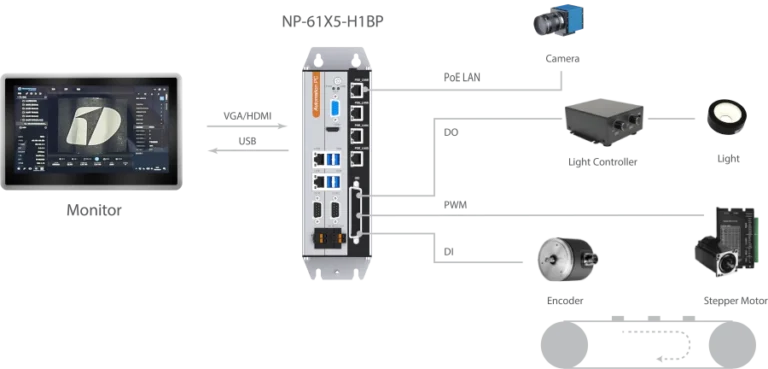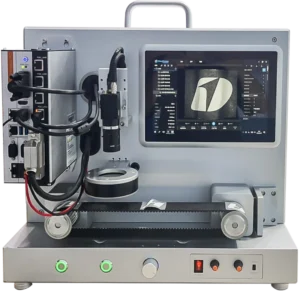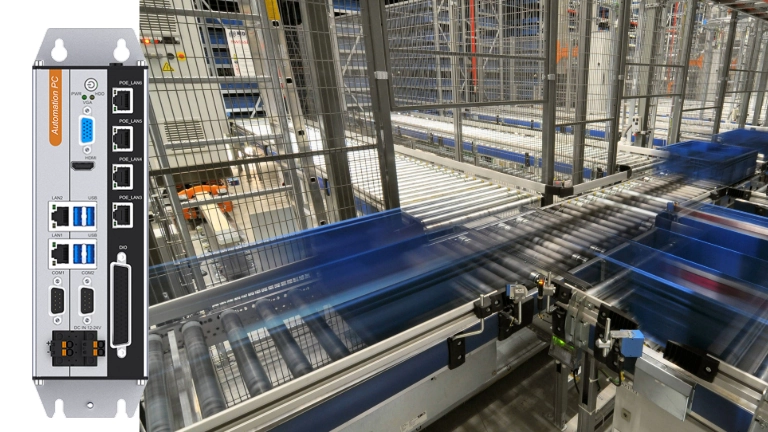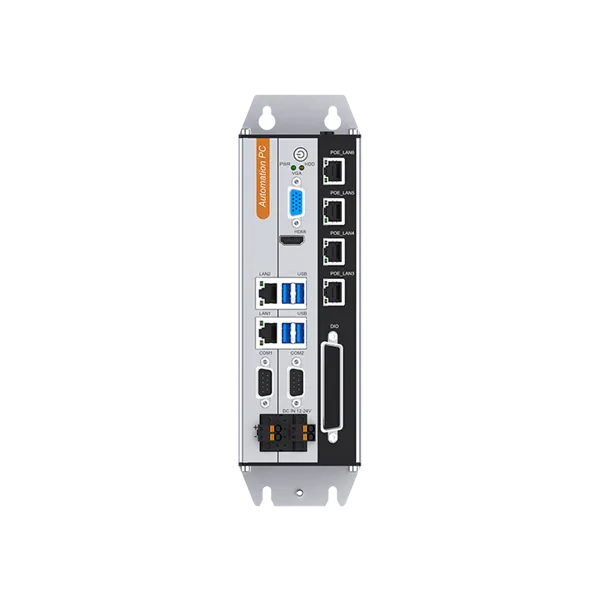Maximizing Machine Vision Performance with FPGA-Based I/O Flexibility on Nodka's Automation PC
In the ever-evolving landscape of industrial automation and machine vision, the demand for real-time data acquisition, precise control, and flexible configurations is growing. Engineers and product developers working on automation processes require systems that can seamlessly integrate various components—like cameras, encoders, motors, and lighting systems—while providing the flexibility to adapt to the unique requirements of each application.
Nodka’s NP-61×5-H1BP Automation PC is designed specifically to meet these demands, offering unparalleled I/O flexibility through its FPGA-based I/O interface. By leveraging the FPGA-based I/O architecture of the NP-61×5-H1BP, along with its desktop processing power and advanced features, this system effectively addresses the complex and unique demands of machine vision applications.
Key Features of the NP-61x5-H1BP
The NP-61×5-H1BP stands out for its flexibility and performance in machine vision applications, with several features designed to enhance the efficiency and effectiveness of automation systems:
- 2× Intel i210 GbE LAN controllers: These controllers enable high-speed data transfer, ensuring smooth communication between the NP-61×5-H1BP and external devices.
- 4× Intel i210 GbE LAN PoE controllers: The PoE capability provides power to connected devices like cameras while reducing the need for complex wiring.
- 16× isolated DI: The system supports isolated Digital Inputs, allowing for reliable, noise-free communication from encoders or sensors. It also supports 2× Encoder A/B/Z differential interfaces, which provide precise position feedback for motion control.
- 16× isolated DO: The Digital Output interface supports 2× PWM output interfaces, ensuring precise control of actuators like stepper motors.
- SDK (Windows and Linux): Nodka provides comprehensive SDKs to allow developers to customize and configure the I/O for their specific application. The SDKs include support for DIO (Digital I/O) and light control, as well as EtherCAT communication for more complex industrial networks.

Understanding the Block Diagram of NP-61x5-H1BP for Machine Vision
The diagram above showcases the key components connected to the NP-61×5-H1BP, demonstrating how it functions as the central processing unit in a machine vision system:
- PoE LAN Controllers: The system includes PoE (Power over Ethernet) LAN controllers, which are connected to machine vision cameras. These controllers not only transmit data but also supply power, simplifying wiring by eliminating the need for separate power cables.
- Digital Output (DO): The DO interface connects to the light controller to control the lights. Through precise timing, the light controller ensures that the camera captures clear images under the correct lighting conditions for high-quality inspections.
- PWM (Pulse Width Modulation): The PWM output connects to the stepper motor, driving precise movements of machinery or conveyor belts. The motor’s movement can be finely tuned, ensuring accurate positioning for imaging or inspection tasks.
- Digital Input (DI): The DI interface receives input from an encoder that tracks the real-time position and movement of objects. This data is critical for synchronizing the camera’s operations with the movement of items on the conveyor, ensuring the vision system captures images at the right moment.
Besides the PoE cameras, each of these components is connected and controlled by the FPGA-based I/O interface of the NP-61×5-H1BP, allowing for high-speed, low-latency data exchange and real-time control.
The Advantages of FPGA-Based I/O Flexibility in Machine Vision
- Real-Time Data Processing FPGA enables parallel processing of I/O signals, which is critical in machine vision applications where multiple devices—such as cameras, motors, and sensors—must be controlled simultaneously. This parallelism significantly reduces latency, allowing the system to respond to changes in real-time.
- High-Speed, Low-Latency Communication The FPGA’s ability to process signals at high speeds ensures minimal latency between input (from encoders, sensors) and output (to motors, lights). This is especially crucial in fast-paced automation environments where delays can lead to errors in inspection or production.
- Customizable I/O Configurations Unlike traditional I/O systems, FPGAs can be reprogrammed to adapt to new requirements without replacing hardware. This makes the NP-61×5-H1BP highly versatile, as it can be reconfigured to meet the specific needs of different machine vision tasks—whether it’s changing the timing of a motor or adjusting the illumination for an image capture.
- Improved Precision and Control The PWM control of the stepper motor through the FPGA-based interface ensures precise positioning and motion control. This level of precision is vital in applications like robotic vision and optical inspection, where exact movements and real-time adjustments are necessary for successful operation.
- Simplified Integration with Peripheral Devices The NP-61×5-H1BP’s I/O flexibility, combined with its support for PoE LAN, EtherCAT, and other industrial protocols, makes it easy to integrate with a wide range of machine vision peripherals. Developers can connect cameras, motors, encoders, and light controllers without needing extensive rewiring or reconfiguration, reducing setup time and complexity.
Real-World Machine Vision Applications of the NP-61x5-H1BP

In a typical machine vision setup, the NP-61×5-H1BP can be used to control a system where a conveyor moves objects through a camera’s field of view for inspection:
- The encoder sends position data to the NP-61×5-H1BP via the DI interface.
- Based on this data, the system triggers the DO to activate the light controller, ensuring the object is properly illuminated for the camera.
- The camera captures the image, and the FPGA processes the data to make real-time adjustments.
- The PWM signal controls the stepper motor, adjusting the position of the object if necessary for a second inspection or movement.
This workflow demonstrates how the FPGA-based I/O flexibility of the NP-61×5-H1BP allows for precise synchronization between different components, ensuring seamless and accurate operation in high-speed production environments.
With comprehensive SDK support and advanced features like PoE LAN controllers, isolated digital I/O, and PWM output, the NP-61×5-H1BP stands as a versatile and efficient choice for engineers looking to maximize the performance of their machine vision systems to meet the unique requirements of various automation tasks, from quality inspection to robotic control.
Talk to us today to learn more about how the NP-61×5-H1BP can be tailored to meet your specific machine vision needs.


